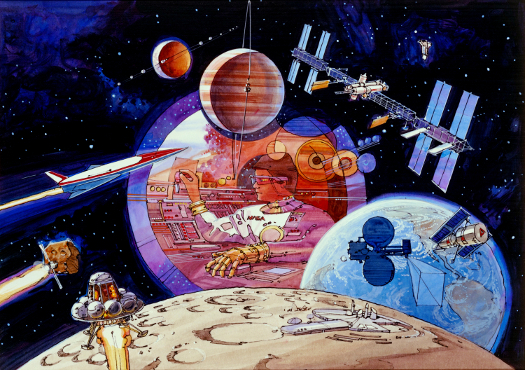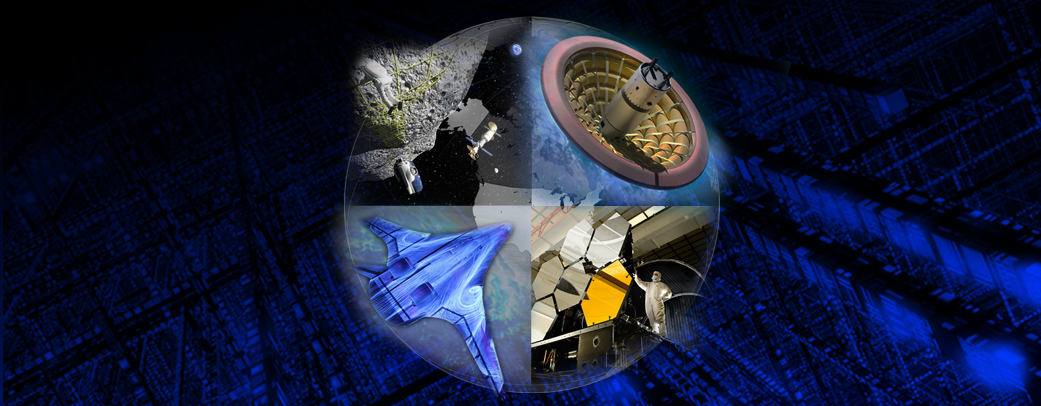2024 Summer Seminar Series
The 2024 series consists of six seminars highlighting Ames Research Center’s diverse capabilities and expertise in multiple subject areas such as lunar science and missions, human space exploration, asteroid threats, and computing.
Tony Colaprete
VIPER: A Mission to Better Understand Lunar Water
Tuesday, July 16 at 11:00AM Pacific Daylight Time
Abstract:
While significant progress has been made in understanding lunar volatiles from orbital observations, measurements at a range of scales from centimeters to kilometers across the lunar surface are needed to validate “volatile mineral models” for use in evaluating the resource potential of volatiles at the Moon. To this end, the primary mission goals for VIPER (Volatiles Investigation Polar Exploration Rover) are to (1) provide ground truth for models and orbital data sets, including temperatures at small scales, subsurface temperatures and regolith densities, surface hydration and hazards, (2) correlate surface environments and volatiles with orbital data sets, and (3) address key hypotheses regarding polar volatile sources and sinks, retention and distribution, which are key to developing economic models and identifying potential locations for further resource evaluation. The VIPER mission is a lunar polar volatiles prospecting mission developed through NASA’s Science Mission Directorate (SMD) Planetary Science Division. The mission includes a rover-borne payload that can locate surface and near-subsurface volatiles, excavate and analyze samples of the volatile-bearing regolith, and demonstrate the form, extractability and usefulness of the materials.
Biography:
Anthony Colaprete is a Planetary Scientist at the NASA Ames Research Center. Dr. Colaprete has led or participated in several flight projects, including being PI and Payload Manger for the LCROSS mission and the PI and Instrument Manager for the LADEE UVS instrument. Currently Dr. Colaprete is the PI for the NIRVSS instrument, an instrument that flew on Astrobotic Peregrine lunar lander Misison-1 and is one of four instruments on the VIPER rover mission. Dr. Colaprete is the lead Mission Scientist for the Volatiles Investigating Polar Exploration Rover (VIPER) lunar rover mission. Over the last decade Dr. Colaprete has worked to migrate terrestrial resource exploration techniques and principles to lunar and Mars resource exploration, developing an “applied planetary science” framework that bridges the gap between science, exploration, and technology.
Victor Yeh
Micro-RNA: Enabling Personalized Diagnostics for Radiation Exposure and Beyond
Thursday, July 18 at 11:00AM Pacific Daylight Time
Abstract:
As flights travel beyond Low Earth Orbit (LEO), crew members will need self-contained, fully independent medical diagnostic capabilities. In addition to physical requirements such as mass, volume, and shelf life, diagnostic devices must be reliable and easy to use. These needs can be met with next-generation technologies, a highly promising one of which is the use of micro-RNA (miRNA) biomarkers. miRNA is found in fluids other than blood, such as urine, saliva, and sweat, allowing for non-invasive medical screening. Recent studies have shown that the expression of certain miRNAs is responsive to radiation. Given individual differences in sensitivity to radiation exposure, biomarker screenings can enable personalized medicine for each crew member. However, miRNA diagnostics are not yet commercially available, so new hardware must be developed to perform this screening. Project RADREADS aims to automate a laboratory assay to analyze miRNA. This hardware will prepare the sample, extract the miRNA, and then amplify and detect specific miRNA sequences that correlate with radiation exposure. In this talk, we will share our progress, results, and future work in this effort.
Biography:
Victor Yeh has been at NASA Ames for five years, joining as a fluidics engineer and now serving as Acting Branch Chief for the Instrumentation and Engineering Technology R&D Technical Area in Code RE. Prior to NASA, he worked in both academia and industry, with a particular interest in the intersection of engineering and life sciences.
Beginning his career at Endevco, a sensor company, Victor worked on military and aerospace micro-accelerometers. He then joined UC Berkeley, developing microfabrication processes for RF devices, before moving on to the life science company MilliporeSigma. As a technical lead for their microfluidic division, Victor led the development of new products for their integrated cell culture and imaging platform.
At NASA, Victor has worked on space biology and medical diagnostic projects such as Wetlab-2, E-Nose, and LEIA. Most recently, he was a co-investigator for project RADREADS, which explored the use of novel biomarkers to diagnose physiological responses to radiation.
Going forward, Victor is excited to grow Code RET and utilize their unique capabilities to advance NASA’s mission in space biology, astrobiology, and beyond.
Erin Flynn-Evans
Sleeping Aloft: What Do We Know and What Do We Need to Know as Humans Travel to the Moon and Mars
Tuesday, July 23 at 11:00AM Pacific Daylight Time
Abstract:
Astronauts and pilots face many challenges related to sleep and circadian rhythms that humans living and working on the surface of the Earth do not experience. Commercial airline pilots often endure sleep disruption due to jet lag, sleep environment-related disruption due to frequent sleep on an airplane and in hotels, elevated workload, and stress. Pilots must also work at adverse circadian phases when their drive to sleep is intense. These factors can lead to on-the-job fatigue and performance impairment. Astronauts on the International Space Station experience the additional challenge of living in low-Earth orbit, where they experience a sunrise and sunset every 45 minutes as they circle the Earth. This photoperiod can exacerbate circadian rhythm misalignment, increasing the risk of performance error. This presentation will review the sleep and circadian challenges faced by pilots and astronauts, the countermeasures developed to mitigate sleep and circadian issues, and discusses how the work that we’ve accomplished in these populations so far will affect missions to the Moon and Mars.
Biography:
Dr. Flynn-Evans is the director of the Fatigue Countermeasures Laboratory at NASA’s Ames Research Center. She holds a PhD from the University of Surrey and an MPH from the Harvard School of Public Health. Prior to joining NASA, she was an Instructor in Medicine in the Division of Sleep Medicine at Brigham and Women’s Hospital and Harvard Medical School. Dr. Flynn-Evans has extensive research experience examining the short and long-term effects of sleep loss and circadian misalignment in occupational settings, including among astronauts, airline pilots, physicians, and other shift workers.
Jessie Dotson
The Asteroid Threat Assessment Project
Tuesday, July 30 at 11:00AM Pacific Daylight Time
Abstract:
An asteroid impact on Earth is an extremely unlikely event – but one with potentially catastrophic consequences. While addressing a potential asteroid impact would require participation from multiple agencies, NASA is the US lead for planetary defense. The Asteroid Threat Assessment Project (ATAP) at NASA Ames is an interdisciplinary, cross-directorate project which supports NASA’s Planetary Defense Coordination Office by applying Ames’ expertise in planetary science, atmospheric entry, high performance computing, and risk assessment to planetary defense. Dr. Dotson will provide an overview of NASA’s planetary defense program and highlight ATAP’s expertise and contributions.
Biography:
Jessie Dotson participated in the formulation of ATAP and currently serves as the Deputy Project Manager. In addition, Dotson is currently the lead champion for Ames Transition to Open Science and the deputy principal investigator for the Pandora mission. She has previously served as the deputy division chief for the Space Science and Astrobiology Division, the project scientist for Kepler/K2, and the astrophysics branch chief.
Alonso Vera
Toward Earth-Independent Human Spaceflight Missions
Thursday, August 1 at 11:00AM Pacific Daylight Time
Abstract:
Human space flight has largely depended on real-time control, guidance, decision-support, and problem solving from the ground for the past 60 years. Human exploration beyond low-Earth orbit will require a greater level of autonomy than is currently possible. This talk will discuss the history of NASA’s human space flight missions in this context and the current approach to increasingly Earth-independent missions including advances in communication technologies, advanced sensor networks, onboard intelligent systems, and crew preparation.
Biography:
Dr. Alonso Vera is the NASA Senior Scientist (ST) for Distributed Collaborative Systems. He has worked at NASA since 2000 and served as chief of the Human Systems Integration Division from 2010-23. Dr. Vera has cross-disciplinary expertise in human performance, human-computer interaction and artificial intelligence. He has led the development of software systems across NASA robotic and human space flight missions including Mars Exploration Rovers, Phoenix Mars Lander, Mars Science Laboratory, Space Shuttle, International Space Station, and Exploration Systems. Dr. Vera received a Bachelor of Science from McGill University, a Ph.D. from Cornell University and a Post-Doctoral Fellowship in Artificial Intelligence at the School of Computer Science at Carnegie Mellon University.
Michael Lowry
Neuromorphic Computing: Mapping Neuroscience to Silicon and Prospects for Space Missions
Tuesday, August 6 at 11:00AM Pacific Daylight Time
Abstract:
Neuromorphic computing maps neuroscience to silicon. The human brain performs exascale computing while consuming only twenty watts of power and embodies the only general purpose intelligence known to date in the universe. The individual computing elements – neurons – are inherently noisy, yet the overall computation is coherent and resilient. These properties could be enabling for future space and aviation missions, whose avionics will need to provide higher levels of autonomous capabilities even in the harsh environment of space. This talk describes both the history and recent results in neuromorphic computing. Exploratory small spacecraft missions have demonstrated neuromorphic edge computing in low earth orbit. Technology demonstration missions in harsher radiation environments are being planned, where neuromorphic co-processors could provide a force multiplier to the general-purpose high-performance space computer available by 2026. The talk concludes with a roadmap to space supercomputing based on heterogeneous computing; incorporating general purpose CPU, GPU, and neuromorphic cores.
Biography:
Dr. Lowry serves as NASA’s Chief Scientist for Reliable Software Engineering. He became interested in Neuromorphic computing as a means of radically improving compute power and energy efficiency for NASA’s embedded aerospace missions. He has recently served as PI for the RadNeuro (Radiation-tolerant Neuromorphic Computing) project – to close the gap between terrestrial Neuromorphic Computing capabilities and embedded space computing.
Lowry has been PI on advanced software engineering technologies through NASA Aeronautics and Space R&D programs. The major theme of his research has been the automation of mathematically based methods for software engineering including generation and verification of NASA aerospace software systems. During Project Constellation he led the definition of the Lunar Surface Systems Software Architecture. Dr. Lowry managed the NASA Ames software analysis of the Toyota unintended acceleration at the request of the National Transportation Safety Board in 2010.
Lowry received his MS/BS from MIT and his PhD from Stanford University in Artificial Intelligence. Dr. Lowry is an IEEE Automated Software Engineering Fellow, with numerous publications.



























